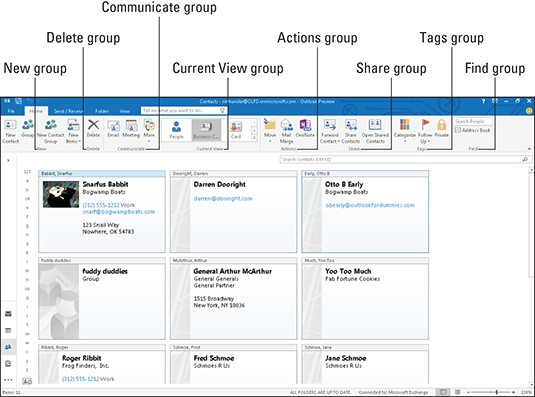- Specify the parts of a person’s name. When you create a new contact, whatever name you enter in the Full Name box is automatically parsed into separate fields for the Title, First, Middle, Last, and Suffix. Outlook doesn’t always do a perfect job of this. You can access a dialog box for entering each of those pieces of information by clicking the Full Name button as you are creating a new contact.
- Set the File As order. The File As setting for a contact determines its order in the alphabetical arrangement of contacts. By default it’s Last Name, First Name, but you can change that. For example, you might want a company to appear by the company name, not the last name of your contact there. Set the File As setting for an individual contact in its record by double-clicking it from the People app and then changing its File As setting in the window that appears.
- Design the business card layout. The default card design shown in Business Card view can be modified. Open a contact in its own window, and then on the Contact tab, click the Business Card button and then work in the Edit Business Card dialog box to modify the card design and the fields it includes.
- Use more fields. The fields that appear by default for a contact when you open it in its own window are just a subset of the available fields. To see more fields, open the contact and then on the Contact tab, click Details. Some of the additional fields include Nickname, Manager’s Name, Spouse/Partner, Birthday, and Anniversary.
- Start a new contact based on an existing one. If you have multiple contacts who all work for the same company, a lot of the fields will likely be the same for them, such as mailing address and web page address. To save time, you can start a new contact based on an existing one. Open the existing contact in its own window, and then on the Contact tab, click the lower portion of the Save & New button, so that a menu appears. From that menu, select Contact from the Same Company.
- Add non-text content to contact notes. Open a contact in its own window and then click in the Notes area. On the Insert tab you’ll find many choices for content you can insert in the Notes area, including pictures, shapes, icon, charts, SmartArt, equations, symbols, and WordArt.
- Mark a contact as private. Perhaps you have some contacts on your Contacts list you would rather not share. To exclude a particular contact from being shared, open the contact in its own window, and on the Contact tab, click Private.
- View someone else’s shared contacts. You can share your contacts with the Home tab’s Share Contacts button. To view someone else’s shared contacts, click the Open Shared Contacts button (on the Home tab) and then click the Name button and select the person whose contacts you want to see. If that person has shared their Contacts folder, you’ll be able to browse it (minus any they have marked as Private). Obviously, this works best in a business environment where everyone is on the same mail or SharePoint server.
- Check for duplicate contacts. Wouldn’t it be nice if Outlook would tell you if you try to create a new contact for someone who is already on your list? You can make that happen. Choose File, Options, and click People. In the Names and Filing section, select the Check for Duplicates When Saving New Contacts check box.
- Create a new view. On the Home tab, open the Current View gallery and choose Manage Views. From there you can create your own custom view. Start by selecting an existing view and clicking Copy. Then select the copy and click Modify. Your new view will appear in the current View gallery alongside standard views like Business Card, Phone, and List.






